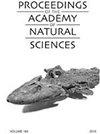Sponge and mollusk associations in a benthic filter-feeding assemblage in the middle and lower Xingu River, Brazil
IF 0.5
4区 环境科学与生态学
Q4 BIODIVERSITY CONSERVATION
Proceedings of the Academy of Natural Sciences of Philadelphia
Pub Date : 2019-02-01
DOI:10.1635/053.166.0113
引用次数: 4
Abstract
ABSTRACT. During a pilot survey, sponges and mollusks were sampled from the bottom of the middle Xingu River (rapids) and lower Xingu River (ria) via hand-picking in shallows and trawling and surface-supplied dives in deeper waters. The survey revealed a benthic community composed of eight sponge species in four genera and three families, and added six species to the Xingu Basin fauna. Sponges exhibited distinct variation in body shape corresponding to local environmental conditions such as water depth, current velocity and available substrates. Sponges inhabiting rocky bottoms in swift currents (rapids) typically formed crusts. Those in the deeper, calmer waters of the ria attained massive and elaborate forms while attached to infaunal bivalves. Oncosclera navicella and Drulia cristata exhibited crusts and massive forms as adaptations to rapids and ria, respectively. In the middle to lower Xingu, sponges encrusted the shells of eleven species of bivalves (seven infaunal, three epifaunal, and one infaunal/epifaunal) and one infaunal/epifaunal gastropod. Bivalves provide key substrates for supporting sponges above the sand, mud and detritus of the Xingu ria. Potential impacts of the Belo Monte Dam complex on the sponge fauna of the middle Xingu rapids are discussed.巴西新古河中下游底栖动物滤食性组合中的海绵和软体动物
摘要。在一次试点调查中,通过在浅水区手工采摘、在深水区拖网捕鱼和水面供应潜水,从新古河中部(急流)和新古河下游(ria)的底部对海绵和软体动物进行了采样。调查显示,海底生物群落由三科四属八种海绵物种组成,新谷盆地动物群增加了六种。海绵在体型上表现出明显的变化,这与当地的环境条件相对应,如水深、流速和可用基质。海绵栖息在湍急的水流(急流)中的岩石底部,通常形成结壳。那些在里亚海更深、更平静的水域中,附着在臭名昭著的双壳类动物身上时,形成了巨大而精致的形状。舟状癌巩膜和脊状瘤巩膜分别表现出结壳和块状,以适应急流和ria。在新谷中下游,海绵包裹着11种双壳纲动物(7种腹足纲动物、3种表目动物和1种腹足目/表目动物)和1种腹足纲动物的外壳。Bivalves为支撑新古里亚的沙子、泥土和碎屑上方的海绵提供了关键的基质。讨论了贝洛蒙特大坝复合体对新谷中部急流海绵动物群的潜在影响。
本文章由计算机程序翻译,如有差异,请以英文原文为准。
求助全文
约1分钟内获得全文
求助全文
来源期刊

Proceedings of the Academy of Natural Sciences of Philadelphia
生物多样性保护-生物多样性保护
自引率
0.00%
发文量
4
期刊介绍:
The Proceedings (ISSN 0097-3157) has been published continuously since 1841. Many volumes are still available in their original printings. Early volumes are unbound, constituting two or three issues per year. Quantities of some volumes may be limited. Early volumes may have slightly soiled cover sheets, but the text blocks are perfect.
 求助内容:
求助内容: 应助结果提醒方式:
应助结果提醒方式:


